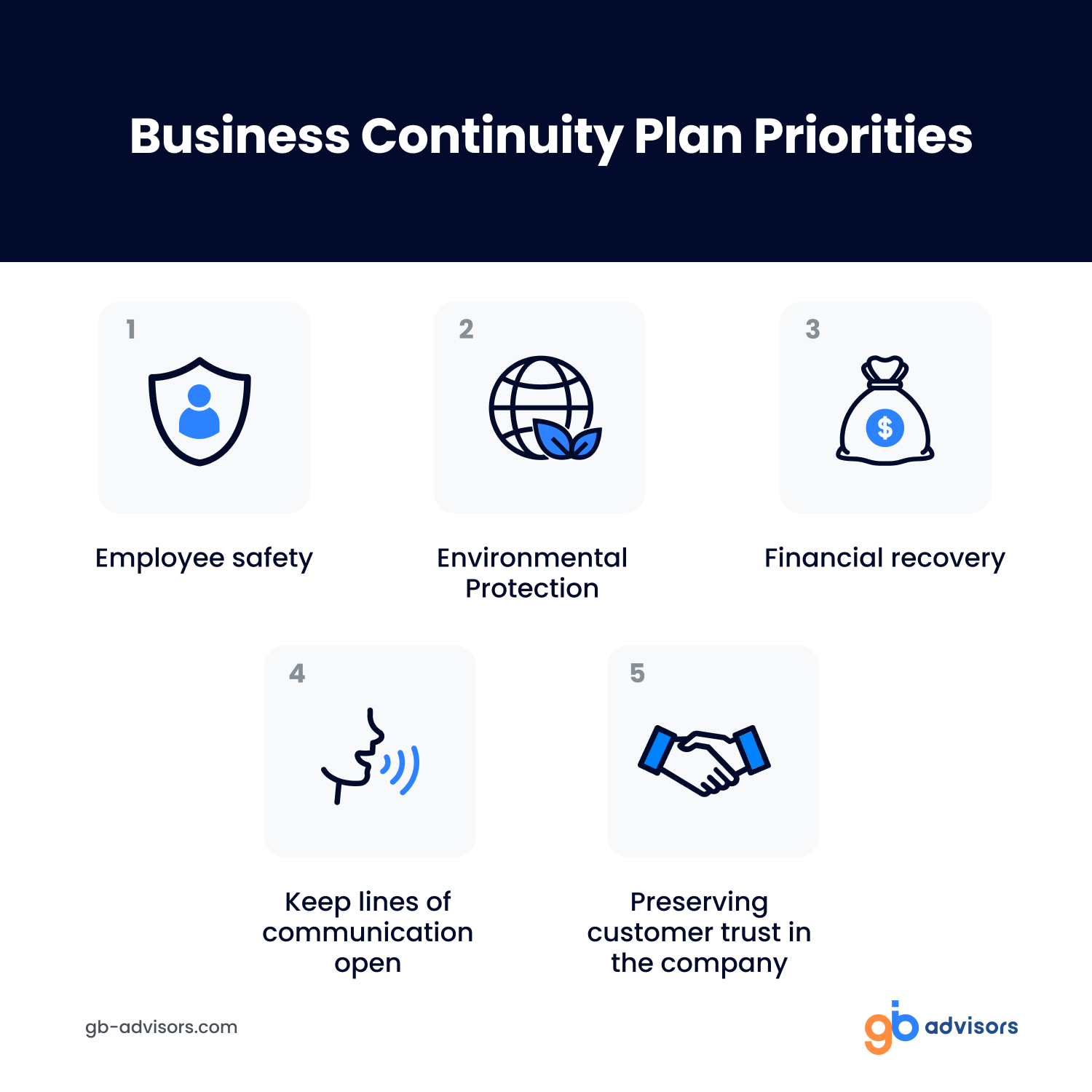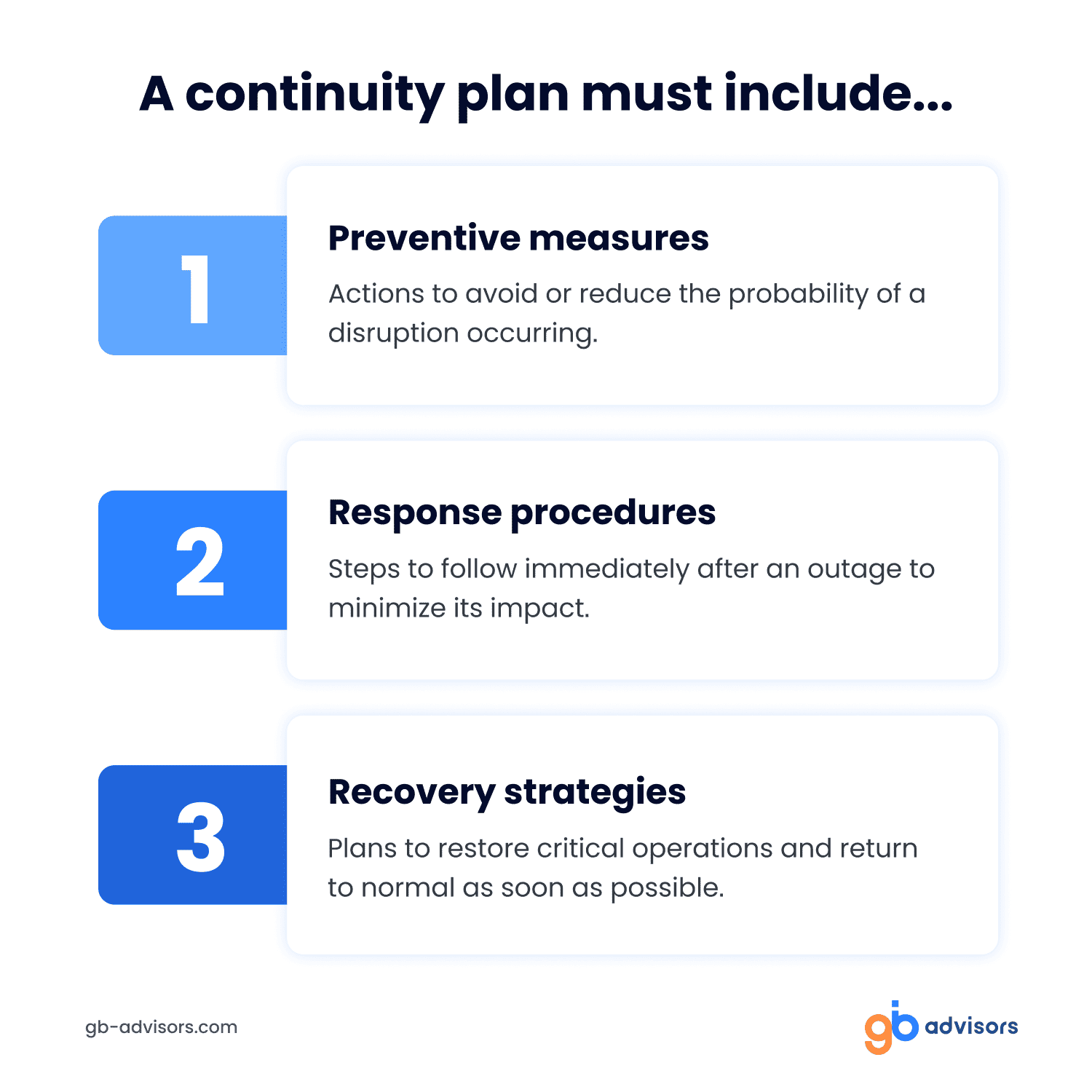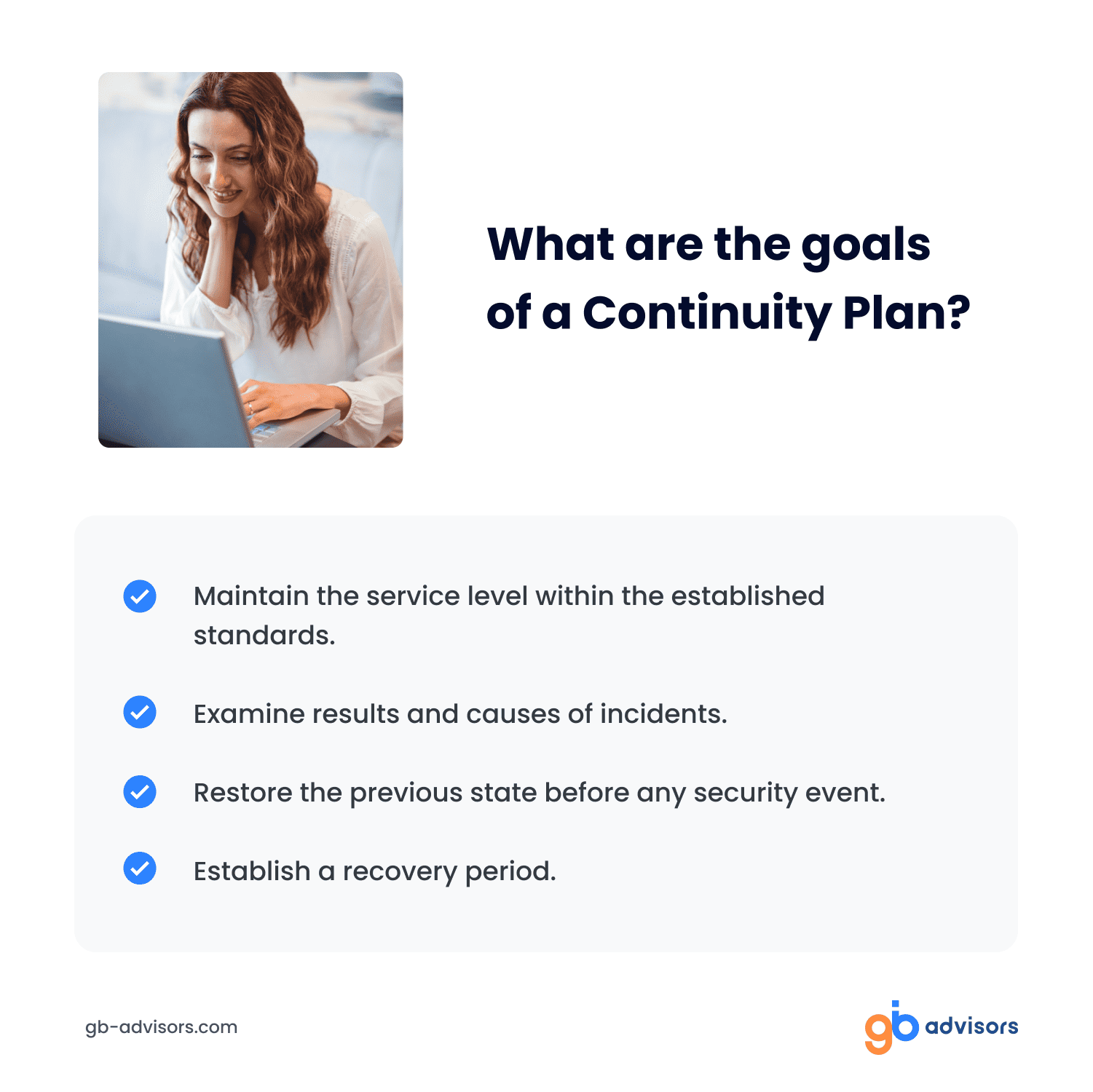Have you ever wondered what would happen if there was a breakdown in the electrical system or if your website was unavailable? What if your company was hit by a flu pandemic or other virus?
Well, we all have experience with the latter. Precisely after the coronavirus pandemic, the importance of having a prevention, protection, and response plan for possible security incidents has become a priority.
Today, organizations are exposed to a variety of internal and external threats. This situation further underscores the need for robust plans and procedures to ensure the continuity of your business.
What is a business continuity plan?
A business continuity plan (BCP) is a set of procedures and strategies designed to ensure that a company continues to operate in the event of major disruptions: natural disasters, equipment failures, cyber-attacks, etc. Or any other situation that may affect the company’s ability to operate normally.
The main objective of a BCP is to minimize the impact of a business interruption. Also, to ensure a quick and effective recovery to maintain essential business operations. A BCP includes preventive, response, and recovery measures, as well as plans for critical business continuity and crisis management.

Types of business continuity projects
There are several types of business continuity projects that a company can undertake:
Business Continuity Plan (BCP)
This project aims to design and develop a plan to ensure that critical business operations can continue in the event of unexpected interruptions.
ICT (Information and Communication Technologies) Continuity Plan
It is a set of strategies and actions designed to ensure that an organization can continue to function in the event of an interruption or failure in its IT and communication systems. The objective of the ICT Continuity Plan is to guarantee the availability, integrity, and confidentiality of business-critical information and to minimize the economic and reputational losses associated with a service interruption.
Although a Business Continuity Plan (BCP) has a broader scope than a Technology Continuity Plan (ICTCP), due to the inclusion of non-technological processes and assets, both basically share the same phases in their preparation.
Disaster Recovery Plan (DRP)
This project is focused on minimizing the impact of natural disasters, system failures, and other catastrophic events so that the organization can recover quickly.
Features of a business continuity plan
Indeed, a business continuity plan is a set of strategies and procedures. But what should these procedures look like, and what are the elements that make it up?
A business continuity plan must have procedures that are:
Comprehensive: this means that the plan must cover all possible scenarios that could jeopardize business continuity. From natural disasters to technological or security problems, to labor or legal conflicts. It is important to identify each of these scenarios and have a clear response for each of them.
Practical: procedures must be designed in such a way that they can be carried out quickly and accurately. Without requiring specialized training or access to external resources.
Efficient: the plan must allow the recovery of the business in the shortest possible time. It should minimize losses and ensure the continuity of critical operations. To achieve this, it is critical to establish clear priorities and have the necessary resources to carry out each task.
Adaptable: the plan must be flexible and adaptable to changing circumstances. The company should regularly assess risks and update the plan accordingly. It must also ensure that it remains relevant and effective in any eventuality that may arise.
Likewise, a BCP is generally composed of the following elements:
Strategy: defines how the company plans to respond to a disruption in its normal operation. This strategy must be clear and concise, and aligned with the company’s objectives.
Organization: identifies the key people who will be responsible: Who will implement the plan in the event of an emergency? It is also important to define specific roles and responsibilities for each team member.
Processes: establish the procedures necessary to maintain the operation of the company in the event of a disruption. This includes:
- Identification of critical processes.
- Definition of backup procedures.
- Creation of communication protocols.
Technology: Technology plays a fundamental role in business continuity. Any BCP must take into account systems, data, and application backup.
Finally, it is vital to consider how disruption will affect the company’s suppliers.
A good business continuity plan must include measures to minimize the impact on suppliers. Both to ensure the continuity of the supply chain and to avoid legal or contractual problems in the event of non-compliance with obligations.
Why is it critical to develop a Business Continuity Plan?
We all know what 2020 meant for many businesses. According to Fortune, more than 100,000 businesses (of all sizes) in the U.S. that had to “temporarily” shut down because of the pandemic did not resume operations.
A continuity plan helps reduce the risks of unforeseen events and promotes business resilience. It is essentially a roadmap that allows you to:
Ensure business survival: it guarantees the continuity of business operations in the event of a disruption.
Protect the company’s reputation: a disruption in the normal operation of the company can negatively impact its reputation and the trust of customers, suppliers, and employees.
Comply with legal and contractual requirements: In some cases, companies are required by law or by contractual agreements with customers or suppliers to have a continuity plan in place. Failure to comply with these requirements can have negative legal and economic consequences.
Reduce costs: A well-designed BCP can prevent financial losses, reduce downtime and minimize data recovery needs.
Phases of a Business Continuity Plan
The following guide provides a step-by-step process for creating an effective BCP, highlighting the phases and some examples.
Phase 0: Scoping
When defining the scope, consider all of your company’s critical functions and resources. Analyze your business processes, identify dependencies, and prioritize based on their importance to operations.
It is also important that you involve stakeholders at all levels of the organization. In this way, you ensure a comprehensive understanding of what is at stake.
Remember that a narrowly defined scope can leave essential areas vulnerable. While a scope that is too far-reaching can lead to unnecessary complexity and resource allocation.
Phase 1: Risk assessment
The first step in developing a BCP is to identify the potential threats and risks to your company. Consider the likelihood and severity of each risk, as well as existing mitigation measures.
Example: In a manufacturing company, potential risks could be a power outage, equipment malfunction or bankruptcy of a key supplier.
Phase 2: Business impact analysis
Once the risks have been identified, conduct an analysis to determine the potential impact of each risk on your organization. This involves identifying critical processes, systems, and personnel. As well as assessing the financial and operational consequences of disruption.
Example: For a software development company, an extended power outage could result in server downtime, project delays, and lost revenue.
Phase 3: Plan development
So, once you have identified the risks and their potential impacts, develop strategies to mitigate them and ensure business continuity. Your plan should include:

Example: A retail store might implement preventative measures, such as installing backup generators, response procedures, such as emergency communication protocols, and recovery strategies, such as temporary relocation to another location.
Phase 4: Testing
Therefore, once the plan has been developed, it is essential to test its effectiveness. This can be done through simulation exercises, walk-throughs, or full-scale drills. Testing allows us to identify gaps and weaknesses in the plan and made the necessary improvements.
Example: A financial services company could conduct a simulated cyber-attack to test its response procedures and the effectiveness of its cybersecurity measures.
Phase 5: Maintenance
A business continuity plan is not a one-time effort: it requires ongoing maintenance to ensure its effectiveness. Review and update it periodically to account for changes in your business environment, new risks or lessons learned from testing and actual incidents.
Example: An e-commerce company expanding its product offering and entering new markets may need to reassess its supply chain risks and update its BCP accordingly.
Phase 6: Training and awareness
Finally, make sure employees are aware of the business continuity plan: as well as their roles and responsibilities during a disruption. To do this, you should provide recurring training and updates to keep everyone informed and prepared.
Example: A healthcare provider can offer annual training sessions on emergency response procedures and use internal communication channels to share updates and reminders about the business continuity plan.
Key Tools for Developing and Implementing a Business Continuity Plan
Undoubtedly, a continuity plan cannot be developed effectively without the support of technology. We need cloud storage solutions, for example.
In addition, today there are software such as IT Service Management systems that facilitate the development and implementation of these plans. In fact, ITSM tools include modules designed to help you:
- The Incident Management module allows you to respond quickly to IT incidents that could disrupt your operations.
- Other modules such as Change Management help you understand how proposed changes to your IT environment could affect business continuity.
Indeed, ITSM tools play a crucial role in designing and implementing a contingency plan for catastrophic situations. But above all, they ensure the smooth continuity of day-to-day operations.
If you want to learn more about the benefits of these systems, contact us and let us help 😊




